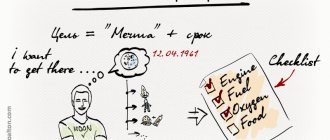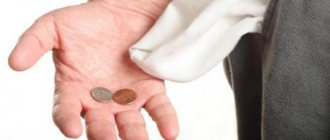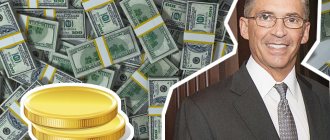Bill Gates is a famous entrepreneur, public figure and one of the founders. The authoritative publication Forbes named him the richest man in the world 16 times.
As of 2021, his capital exceeded $90 billion, while he regularly and seriously engages in charity work. Gates has his own fund, in which he has already invested more than $30 billion.
From Gates' biography you will learn about how this unusual man developed and how he managed to become world famous.
So, here is Gates' biography.
Childhood
Bill Gates as a child
Bill Gates was born on October 28, 1955 in Seattle. Bill was the second child in the family, he has two sisters - the older Christy and the younger Libby.
His father was the famous lawyer William Henry Gates II, and his mother was a teacher, member of the board of directors of financial and telecommunications companies, and president of the national board of United Way International, Mary Maxwell Gates.
His great-grandfather was a mayor and senator, and his grandfather was a vice president of a national bank.
Parents wanted their children to grow up educated people. For this reason, the Gates family did not watch TV on weekdays; instead, they spent their free time talking, playing games and reading.
At the age of 13, his parents transferred the future founder of Microsoft to Lakeside , in the hope that his son would follow his father’s fate and become a lawyer.
At school, Bill Gates fell behind in grammar and civics because he found them boring. The computer tycoon had no problems with mathematics; in this subject he had exceptionally high scores.
In order to somehow stimulate their son in other subjects, his parents promised to pay him 25 cents for every A, but this did not help either.
In 1968 (Gates was in 8th grade), the school purchased computer time from the Computer Center Corporation (CCC).
Bill was enthusiastically interested in a new field for that time and therefore often, together with his friend Paul Allen (future business partner), skipped major classes. Bill's hobby soon bore fruit, and he wrote his first simulation program, which allowed a person to play against a machine (tic-tac-toe).
Bill Gates and Paul Allen
Two enthusiastic young people quickly found flaws in the computers of that time and cracked the seemingly reliable protection of the most modern computer of that time.
They changed the files that stored information about computer time used. Later, CCC specialists discovered a time leak, and young hackers were banned from using computers all summer.
Loner
0
Source:
As a child, Bill read a lot; he devoted all his time to learning new information. The parents were afraid that their son would close himself off from the outside world and withdraw into himself, so they sent him to study at Seattle's Lakeside School. There the boy acquired not only knowledge, but also friends, among whom was Paul Allen.
First job offers
Thanks to their extraordinary skills, those people who once forbade them to use computers for their own purposes realized that these gifted guys could work to improve security, and soon they were given their first serious offer.
Computer Center Corporation invited them to identify flaws and security holes. In exchange, the company offered endless computer time.
Bill was able to satisfy his desire to develop in the computer field, and from that very moment he completely immersed himself in what he loved. Friends day and night with youthful enthusiasm looked for holes in the security systems of the then IT networks. They managed to simultaneously collect global data on modern computer systems, which they then used in the development of their personal business.
The company that provided them with work, Computer Center Corporation, soon went bankrupt , and the friends began to look for their own ways of implementation.
In the early 70s, young geniuses already had the status of experienced programmers, and at that time the reputable Information Science company hired them to write a payroll program . The friends were promised unlimited time for research work, as well as profits from the software they developed.
Quotes
Our modern way of life was not created by politicians. Before 1700, people were as poor as church mice, and their lives were short and brutal. Everything changed when people began to actively invent. Yes, stability and education are extremely important, I will not argue with that, but the real engine of progress is innovation.
When you come up with a good idea, act immediately.
Business is a fascinating game that combines maximum excitement with a minimum of rules.
I'm glad to see how computers are no longer something exotic. They have become a tool that we use every day. This was once my dream, which has now become a reality.
First serious income
As a 10th grade student, Gates himself taught computer science at school. Bill and his friends began to periodically receive orders and earn good money.
Gates constantly developed in this area and wrote more and more new programs.
He developed a program for his school that distributed the class schedule, but for some reason every time he found himself exclusively in a female group of fellow students.
At the age of 17, Bill Gates and Paul Allen developed a program that helped analyze traffic and build special graphs. They also founded the company Traf-O-Data , which distributed the program. For this work they earned 20 thousand dollars .
On December 25, 1972, Bill and Paul received an order to write a software package for Bonneville Dam power distribution. It took a year to develop the program and in the end they received 30 thousand dollars .
Way to success
Gates grew up in an affluent area of Seattle, Washington, with his parents and two sisters. The son of a lawyer and a schoolteacher, Gates attended public elementary school and then Lakeside School, a private college preparatory institution. It was there that he first became interested in the relatively new field of computer programming, met his friend and future business partner Paul Allen, and developed his first computer program at the age of 13.
Gates and Allen then created a company they called Traf-O-Data. They built a small computer to measure traffic and earned about $20,000. The company remained in business until Gates and Allen graduated from high school. Gates then attended Harvard University with the intention of becoming a lawyer like his father. However, by his sophomore year, Bill was more interested in computers and electronics than legal studies.
Bill Gates dropped out of Harvard University, but still graduated 30 years later
Creation of Microsoft
Microsoft Corporation grew out of the bluff and bravado of two undergraduates. Paul showed Bill an advertisement for a home computer kit from MITS. They told the developers that they had adapted a basic computer language called BASIC for the newly created machine. When MITS expressed interest, Gates and Allen spent the next four weeks working frantically to turn their boast into reality.
One small error would mean that the program would not run.
We tried it the first time at MITS and it came home without a hitch. Bill Gates
www.browsebiography.com/bio-bill_gates.html
After writing the first computer language for the personal computer, Gates and Allen founded Microsoft Corporation in 1975. This name comes from the words “microcomputer” and “software”. A year later, Gates left Harvard and focused on creating a new business. He believed that there was a market for software that would expand rapidly as affordable computers were developed for home use.
Microsoft started off on shaky ground. Gates and Allen sold their first commercial software for $3,000. However, Microsoft soon found itself unable to cover its costs, although Gates and Allen received periodic royalties. In addition to this, their program was hacked by hackers. This led Gates to write an "open letter to hobbyists" stating that software should not be copied by the computer community without the developer's permission.
Microsoft Corporation grew out of the bluff and bravado of two master's students - Paul Allen and Bill Gates
Collaboration with IBM
By the end of the 1970s. Computer giant IBM had plans to sell the personal computer for home use. They asked Microsoft to develop a standard operating system for their home computer models. Gates and Allen bought an operating system called Q-Dos, developed by Seattle Computer, for $50,000. Q-Dos was compatible with the Intel processor that IBM was going to use. They then adapted the Q-Dos system and introduced it to IBM. Then Microsoft directed all resources to this system.
Gates learned his early lessons in software well. He insisted that IBM make Microsoft the exclusive software licensee for its home computers, meaning that all IBM products would have Microsoft operating systems. In addition, Gates negotiated an agreement that allowed Microsoft to retain the right to produce and license the software, which they called MS-DOS, to other manufacturers.
Gates and Allen encouraged developers to create programs that would enhance the capabilities of their systems. These negotiations demonstrated that Gates was willing to put aside immediate profits for much larger ones in the future. His plan was based on creating a mass of users for Microsoft products, which would mean that the company would own the industry standard.
When Gates and Allen approached Seattle Computer (the original developer of the software), they did not mention that they were in talks with IBM to develop their operating system. Seattle Computer later sued Microsoft on the grounds that it hid its relationship with IBM in order to buy Seattle's system at a better price. Both companies reached an out-of-court settlement. Gates and Microsoft have not admitted guilt.
Gates and Allen were not chasing short-term profits, but encouraged developers to create programs that would expand the capabilities of their systems
The fight for supremacy and Windows development
Paul Allen, who served as Microsoft's head of research and new product development, left the company in 1982 after being diagnosed with Hodgkin's disease. The following year, Gates faced a major challenge to Microsoft's dominance of home PC operating systems when a company called VisiCorp developed a mouse-driven computer system with a graphics-based user interface rather than one based on the keyboard and MS-DOS. Gates quickly realized that VisiCorp's system would be the wave of the future because it would be much easier for technologically inexperienced people to use.
Bill began the advertising campaign with an announcement at New York's Plaza Hotel that a new Microsoft operating system with a graphical user interface (GUI) would soon be released. This next generation system was to be called Windows. Gates' announcement was a bluff; development had not yet begun, but the marketing ploy worked. People preferred to wait for a system that was compatible with their existing Microsoft products rather than install a completely new one. Windows 1.0 was finally released in 1985. At the same time, Microsoft reported $140 million in revenue, including $46.6 million from foreign users.
In January 1986, Gates launched an ambitious, long-term project to develop a new compact disc, or CD-ROM, storage system that could hold any type of computer file, including music and visual files. In March 1987, he effectively became a billionaire: Microsoft shares rose to $90.75 per share.
The Windows 1.0 operating system was released in 1985
Problems with law
Beginning in 1993, authorities began to crack down on Microsoft. The company was accused of unfair competition, violating the rights of users and computer manufacturers by imposing restrictions on the use of Microsoft products.
U.S. District Judge Thomas Jackson ruled in June 2000 that Microsoft was a monopoly that was illegally exploiting the dominance of Windows, which at that point was installed on more than 95% of the world's PCs. Judge Jackson then ordered Microsoft to be broken up into several smaller companies. However, this decision was overturned on appeal, and the company received a much less severe penalty aimed at curbing some of its business practices. Despite this relatively favorable outcome, Gates continued to battle rivals in American courtrooms over Microsoft's business practices.
And yet Microsoft continued to thrive. Gates stepped down as CEO in 2000, but remained chairman of Microsoft as well as its chief software architect.
Creation of Microsoft and Collaboration with MITS: the beginning of a success story
Bill Gates, 1973-2016
In 1973, Bill entered Harvard University, where the young programmer was not interested in studying. Sure, Bill Gates wanted to gain knowledge in the field of software, but he was attracted to the practical part, not a lot of theory .
Due to numerous absenteeism, having studied only 2 years, he was expelled from the university (1975). When he left, Bill Gates told his teachers that he would make his first million before he was 30.
In 2007, Bill Gates received a higher education diploma from Harvard University for his special services and became a specialist in the field of jurisprudence.
In 1975, Paul Allen learned from Popular Electronics magazine about the world's first microcomputer, the Altair 8800 for the mass market, created by MITS. This was a great chance to prove myself. The computer had no software, and it was necessary to be the first to develop a language for this machine.
1975 Popular Electronics magazine cover
A few days later, Gates contacted the Altair's manufacturers and said that he and Allen had created a version of the BASIC that could be used on the computer. He lied - not a single line was written, but they were interested in the proposal. And the friends had to work at an accelerated pace, creating program code.
Gates worked on the code, Allen simulated Altair's actions on the school computer. After a month and a half, the program was ready.
Surprisingly, everything ended well, and the computer accepted the developed program. This option satisfied the management, which offered the future founders of Microsoft further cooperation.
Microsoft
Microsoft founders Paul Allen (far right below) and Bill Gates with the company's first team
Two months (1975) after concluding an agreement with MITS, young developers founded Microsoft (originally the name was hyphenated Micro-Soft). At the time of its founding, Gates was 20 years old, Allen was 22.
Fun fact: Allen & Gates was one of the company's names, but Bill and Allen decided it was more appropriate for a law or consulting firm.
Since the company did not have the necessary funds, managerial functions at first had to be performed by Gates’ mother, who had serious management experience. The first five customers went bankrupt, but the young people did not give up.
In early 1975, Paul Allen learns that Micro Instrumentation and Telemetry Systems is releasing a new generation of computers, the Altair 8800. Bill Gates gets bold and calls Ed Roberts, who headed this organization. Soon after the interview at MITS, the bosom friends become partners of the company.
View this post on Instagram
A post shared by Bill Gates (@thisisbillgates) on Oct 16, 2018 at 11:58am PDT
Paul Allen and Bill Gates
Initially, they planned the name “Allen and Gates,” but such names are not typical for the high-tech market. Then the guys looked at the name of the employing company, deciding on a specific phrase - Micro-Soft (Microprocessors and Software). Within a year, the hyphen disappeared from the brand name, and the Microsoft trademark was registered in November 1976.
In 1976, Gates also introduced the practice of licensing proprietary software for direct use by computer manufacturers, allowing them to build new operating systems and programming languages into PCs. Such innovation in marketing increased the organization's revenue.
steve jobs y bill gates
Posted by Connor Mcbrath Sunday, September 23, 2012
Bill Gates and Steve Jobs
MITS soon ceased to exist, but Microsoft was able to attract new customers. Apple Corporation, whose founder was Steve Jobs, and Commodore, as well as computer developer Radio Shack, have become new partners of Microsoft.
Friends and business partners began to plan the development of an innovative structure for decades. Allen dealt primarily with technical issues, while Gates focused on developing public relations, contracts, and other business contacts. The result of Microsoft's work was the Microsoft Fortran operating system, which appeared in 1977. This OS can easily be considered the first full-fledged competitor to the standard CP/M system for Intel-based computers.
Embed from Getty Images Microsoft CEO Bill Gates
In 1980, Microsoft achieved success by concluding a deal with the “shark” of the computer business – IBM Corporation. Gates and Allen offered a more attractive system for their new computer than Digital Research, with which IBM had previously collaborated. Not least important for achieving this goal was the friendly acquaintance of Gates’ mother with IBM executives John Opel and John Akers.
Soon, Bill and Paul's company offered the computer market a new system, MS-DOS, which for a long time would become the main OS for Intel-based personal computers. In 1985, Microsoft released Windows, which differed from all previous competitors in its graphic design. Thus began the Windows computer era, although the real breakthrough came only in 1993 after the appearance of the third version of this system - Windows 3.1.
View this post on Instagram
A post shared by Bill Gates (@thisisbillgates) on Oct 2, 2021 at 7:31pm PDT
Bill Gates
In 1986, Microsoft Corporation entered the stock markets. The value of the shares grew rapidly, and within a few months Bill Gates became a billionaire. The company's position is gradually strengthening. By 1988, Microsoft was already the largest computer software developer in the world.
By 1998, Gates becomes the richest person in the world. Now finances allowed him to concentrate his attention on programming, and he announced that he was leaving the organization. Until 2006, Bill was still responsible for product strategy at Microsoft, but decided to step down from business development responsibilities, declaring that he wanted to devote his time to charity.
MS-DOS - the OS that brought success
The world's first personal computer, IBM
In 1980, Microsoft received a proposal from IBM to create an operating system for the world's first personal computer. But Bill Gates was forced to refuse, since the company did not have its own operating system. He recommended contacting Digital Research.
Coincidence? Mary Gates (mother) was president of the national board of United Way International. IBM presidents from different years met there under her leadership.
IBM executives were unable to agree on a price with Digital Research CEO Gary Kildall. In this regard, they again turned to Microsoft for help.
Gates, as with BASIC, needed to provide what he had. He found a quick way out of this situation. Gates contacted a programmer who had already developed the operating system. Microsoft subsequently acquires the rights to the Q-DOS operating system (OS) from Tim Paterson for $50,000. Gates and his team adapted the OS to the needs of IBM and, under the name MS-DOS, it was sold for the same $50,000.
Microsoft retained the copyright to MS-DOS, which allowed them to sell the operating system to other computer manufacturers.
MS-DOS is a disk operating system for computers.
Birth of a Billionaire
At twenty-four, Gates signed a contract with IBM that ultimately made him the richest and most powerful person on the planet. The largest computer company in the world needed an operating system for a new development, and Microsoft set about creating it. The mediator in this deal was Bill's mother, who introduced her son to IBM management. This does not in any way detract from the merits of Gates himself, who was able to convince his partners to entrust them with this important task.
At 24, Gates signed a contract with IBM
Thus, in 1981, the famous text-based operating system MS-DOS (Micro Soft Disk Operation System) appeared, which at that time became the most advanced OS in the world and made personal computers more accessible to the average user. It was adapted not only for BASIC, but also for most popular programming languages. Note that Gates did not write it from scratch. He transferred the “backbone” from OS 86-DOC, the rights to which he acquired from Seattle Computer Produtcs for $75 thousand.
Bill Gates in his youth
In August of the same year, the first IBM computer with an Intel processor based on MS-DOC was released. IBM products occupied the niche of personal computers due to their relatively low cost, while the main competitor, Lisa from Apple (and for some time Microsoft helped Jobs in development), cost $10 thousand and was available only to a select circle.
By the age of 40, Bill Gates became the richest man in the world
Bill did not sell his OS to IBM, but agreed on a percentage of each computer sold by the company. Thanks to this ingenious marketing move, by the age of thirty he became a billionaire (and went down in history as the youngest self-made billionaire), and by the age of forty, the richest man in the world. Computers became a mass commodity, and Microsoft provided itself with jobs and a stable income for many years.
In 1983, Gates announced the release of Microsoft Windows - an OS based on MS-DOS, but with a convenient graphical shell. Its basic principle of a frame window manager (clicking on a link/button opens a new window that does not interact with others) now seems absolutely natural, but for 1983 it was a revolution that opened up wide access to computer capabilities even for people far from the IT sphere - more there was no need to enter the file directory in the system.
At the same time, Microsoft released the Word text editor, which most PC owners still use today - naturally, in its current form it is radically different from the first version. The same applies to Microsoft Excel, which was released in 1985 and within two years supplanted all competitors in the field of spreadsheets.
Evolution of Microsoft Windows In 1995, the Windows 95 operating system was released, which turned out to be so much more powerful than its competitors that it consolidated Microsoft's leadership in the market for many years. In 1996, Forbes recognized Bill Gates as the richest person on the planet. He remained so until 2007, received this title again in 2009 and did not give it up until 2021. In 2018, the entrepreneur lost this title to Amazon owner Jeff Bezos.
Windows era
Windows 1.0x
On November 20, 1985, Microsoft released the Windows 1.0x operating system, which stood out from its competitors in its graphic design. It is from this moment that the era of Windows begins.
Bill Gates with the first version of OS Windows
How did Bill Gates get rich? The stock market and the rapid growth of the corporation's shares in 1986 helped Bill earn his first billion . The company gradually begins to capture the market, and by 1988 international sales reach 48% of all Microsoft software sales.
Antimonopoly Committee
This success did not go unnoticed. In 1998, the company had problems with US antitrust laws. Windows was used in more than 85% of the world's computers , all of which had the Internet Explorer browser installed.
The US Department of Justice has charged Microsoft with violating competition laws. Gates' opponents argued that the browser's close ties to Windows limited its competitors' capabilities. Representatives of Microsoft responded that such a connection makes their product better, because customers get both a browser and an operating system for one price.
During the trial, it was decided to split Microsoft into two companies, one of which would work with operating systems, and the other would develop other applications. This decision was later reversed, and the company managed to reach an agreement with the US government.
Similar proceedings regarding violations of antimonopoly laws are still ongoing.
Books
Bill Gates has published two bestsellers. In these books, the entrepreneur decided to tell his own success story. In 1995, The Road Ahead was published, which was at one time on the bestseller list of the American newspaper The New York Times.
View this post on Instagram
A post shared by Bill Gates (@thisisbillgates) on Dec 22, 2018 at 8:13am PST
Bill Gates with books
In 1999, Gates published the book Business the Speed of Thought. The work has been translated into 25 languages. The author in his publications talks about ways to use computer technology to solve problems in business. Proceeds from the sale of both books were donated to non-profit organizations that support the development of technology and education.
The history of the origin and development of the computer industry was captured in the film “Pirates of Silicon Valley,” released in 1999. The drama was about the confrontation between Microsoft and Apple. Spectators and critics noted the great similarity between the leading actors and their characters. The image of Bill Gates in the frame was recreated by Anthony Michael Hall, Paul Allen was presented by Josh Hopkins.
The end of the Bill Gates era
- In 2008, Bill Gates stepped down as CEO of Microsoft but remained chairman of the board of directors. He explained his departure by the desire to devote more time to the Bill and Melinda Gates Charitable Foundation.
- In 2014, Bill Gates left the post of chairman of the board of directors of Microsoft, but remained a member of this board.
- In 2021, he left the board of directors of the Microsoft company he founded to devote more time to charity. He will remain an advisor to CEO Satya Nadella and continue to be one of the largest shareholders.
Career
In 1989, the businessman founded the Corbis company. The main task of this structure was the licensing of photographs, videos and other multimedia material for the media. Gates' idea was that in the future people would decorate their homes not with paintings, but with electronic reproductions of them.
View this post on Instagram
A post shared by Bill Gates (@thisisbillgates) on Nov 15, 2018 at 6:56am PST
Businessman Bill Gates
Corbis owns the rights to reproduce images of works of art in museums around the world. The St. Petersburg Hermitage, the Philadelphia Museum of Art and the London National Gallery constantly cooperate with the company of the American entrepreneur. Bill Gates personally acquired a collection of rare works by Leonardo da Vinci, which are now on display at the Seattle Art Museum.
In the fall of 2008, Gates registered a new company, bgC3 (Bill Gates Company Three). This acronym stands for Bill Gates' Third Company. The main tasks of the organization are research and analytical. It is a center providing scientific and technological services.
View this post on Instagram
A post shared by Melinda Gates (@melindafrenchgates) on Oct 28, 2018 at 7:59am PDT
Bill Gates and Melinda Gates
In addition, Bill Gates does a lot of charity work. He and his wife Melinda became the founders of the world's largest charitable foundation, the Bill and Melinda Gates Foundation, which provides assistance to all those in need, regardless of nationality. The purpose of this enterprise is to support and improve the healthcare system, as well as overcome hunger in poor countries. From his own funds, Gates partially financed the presidential campaign of Republican George W. Bush in 2004, spending more than $30 thousand.
The entrepreneur is passionate about the ideas of maintaining environmental safety on Earth. In collaboration with Mark Zuckerberg, Bill Gates created the Breakthrough Energy Coalition, whose work is to identify and attract private investment in the production of clean energy sources.
Personal life
Photo: Bill Gates family
Bill is married to Melinda Gates (French). They first met at lunch during an industrial exhibition in New York, at that time she had already held the position of project manager at Microsoft for about four months.
In 1993, he proposed to Melinda. On January 1, 1994, they got married on the beach of the Hawaiian island of Lanai. The couple later had three children (one boy and two girls). People around Bill Gates claim that his character became softer after he had children.
Melinda and Bill's marriage seems ideal: they travel together, learn to sing, founded a charitable foundation and solve huge crossword puzzles that experts come up with for them.
Despite his love for his children, Bill Gates specified in his will that each of them would receive only $10 million . He plans to use the remaining funds for charitable purposes.
The first earnings of a genius
Bill's parents, having noticed their son's craving for computers, apply their unconventional approach to education here. They pay for school fees and books, but while he was at the computer he had to earn his own money.
Gates will raise his children according to the principle of “not giving ready-made things, but encouraging independent achievement of goals.” According to his will, his fortune should go to charitable foundations, and each child should receive 10 million dollars and a decent education.
Gates shows respect for any work and is confident that earthly blessings must be earned, and not expected in the form of manna from heaven.
Charity
In addition to Microsoft, Bill Gates is also involved in charity work. In 1994, he sold some of his securities and founded the William Gates Foundation, named after his father. In 2000, Bill Gates merged the William Gates Foundation and his other charitable projects into the Bill and Melinda Gates Foundation , which is one of the largest in the world.
The Foundation supports social, medical and educational projects, as well as initiatives in the field of gender equality. In 2005, Time magazine awarded the title "Person of the Year 2005" to Microsoft founder Bill Geist and his wife Melinda.
In 2006, Warren Buffett, one of the world's largest investors, announced his intention to bequeath $37 billion to the Bill and Melinda Gates Foundation. This is the largest donation in US history.
In 2021, Bill Gates made his largest donation since 2000. We are talking about 64 million shares of the company, the total value of which is estimated at $4.6 billion. The shares were transferred to a fund founded by Bill and Melinda, but who became the owner of this amount is unknown.
In 1999 and 2000, he also made donations in the form of Microsoft shares, the value of which reached 16 billion and 5.1 billion, respectively.
In 2021, the couple's foundation turned 20, and they published a letter on this occasion on Bill Gates' website. It says that the Gates Foundation has allocated $53.8 billion throughout its existence.
Bill's departure from Microsoft
In early 2008, during the opening of the Consumer Electronics Show, Microsoft's top executive announced that he would be leaving Microsoft in the near future. Gates explained his action in such a way that after his departure he would become closely involved in managing the Bill & Melinda Gates Foundation (which he and his wife created in 2000). This fund helps such areas as education, healthcare; Also, with the help of the fund, a vaccine against AIDS is being developed, assistance programs are appearing for poorly developed countries where the population is starving.
At the end of June 2008, Gates transferred his authority to manage Microsoft to CEO Steve Ballmer (with whom he studied at university). Despite this, Gates continues to remain chairman of the directors. In addition, he remains the owner who has the largest number of shares from Microsoft Corporation (almost 9%).
After Gates' departure, Microsoft continues to work on new products. In October 2009, Windows 7 was released. In 2012, Windows 8 appeared on the shelves. As of July 2013, more than 100 million of its licenses had been sold.
Instead of output
Today it is no longer possible to imagine the work of many offices without computers based on Microsoft products. The guy who started his career in athletic boots made his first billion dollars at 31 years old.
Currently (January 18, 2021), Bill Gates ranks third ($110.6 billion) on the Forbes list of the world's richest people.
Was there something you didn’t like about this article, do you have anything to add, or did you find an error? Be sure to write about it in the comments. Not a single comment will be left unattended!
Article updated 12/04/2020
Management style - workaholic
Gates was known from the start of his career as the epitome of a hard-working businessman, respected by his allies and feared by his competitors. It was his vision that led to Microsoft's enormous success.
It is known that at the beginning of his career, Gates worked 16 hours a day and allowed himself only two three-day vacations during the first 5 years after the creation of the corporation.
Additionally, Gates had an incredible ability to handle the management and technical aspects of Microsoft's operations. He was especially known for his success as a marketing strategist who priced his products for the mass market rather than computer specialists. In 1999, Gates was recognized as one of the most influential people of the last century.
Despite the scale of his activities, Bill Gates does not look like a tiger driven into a business cage, ready to attack his competitors. On the contrary, photos and videos present him to us as a smiling and good-natured American: without arrogance or pretentiousness. He does not demonstrate his influence and wealth and thereby attracts the favor of people.
In 2021, a photo appeared online showing Gates standing in line at a fast food restaurant.











